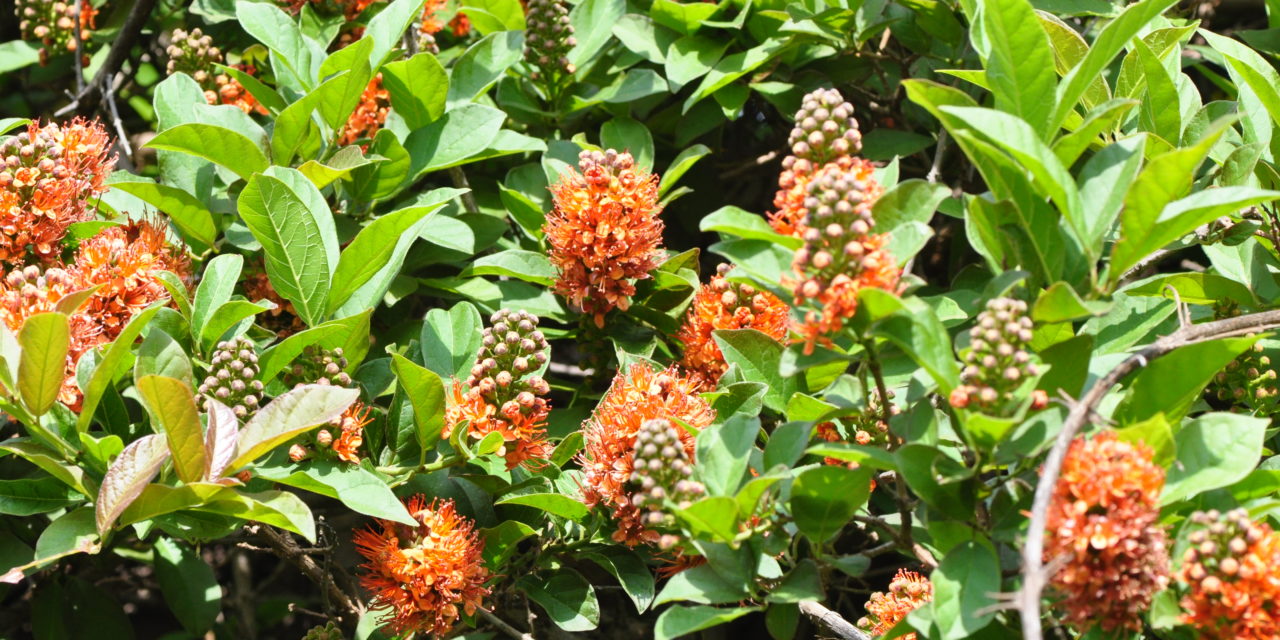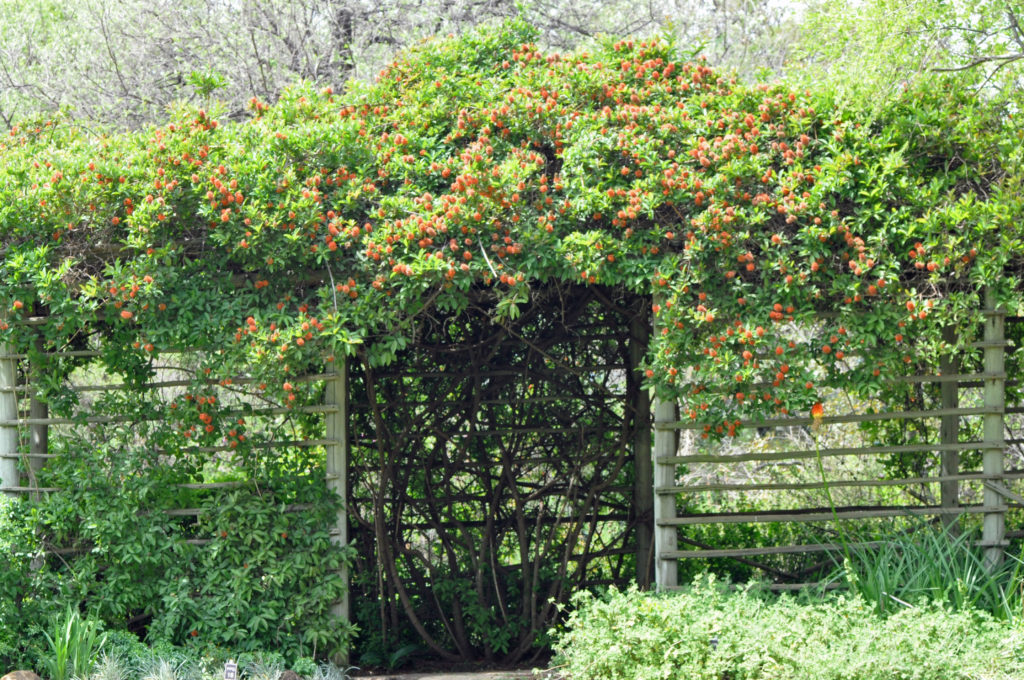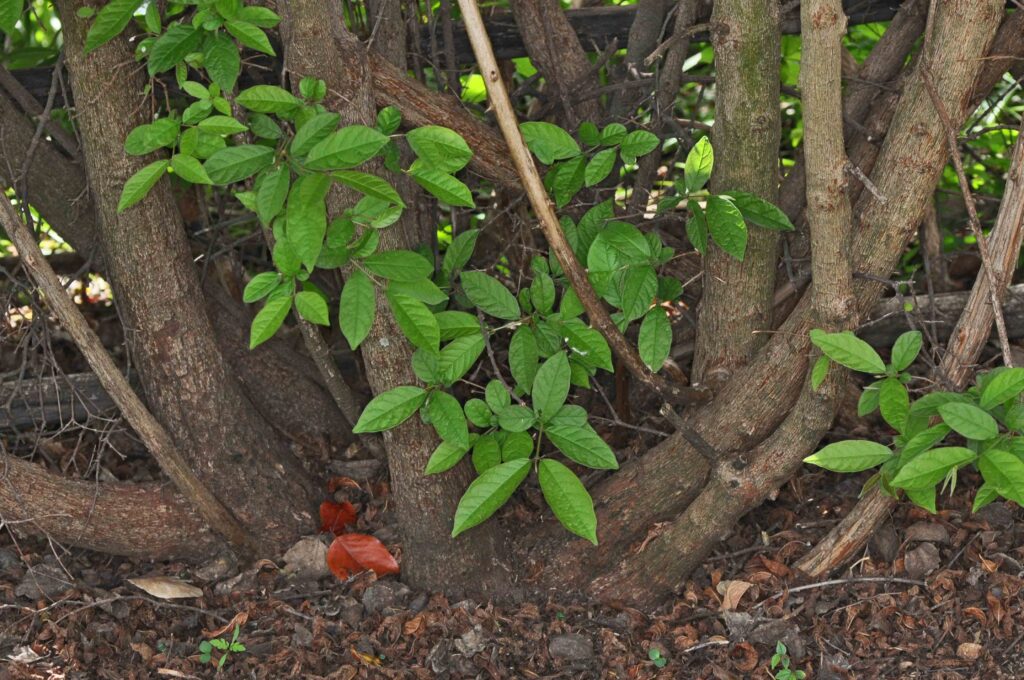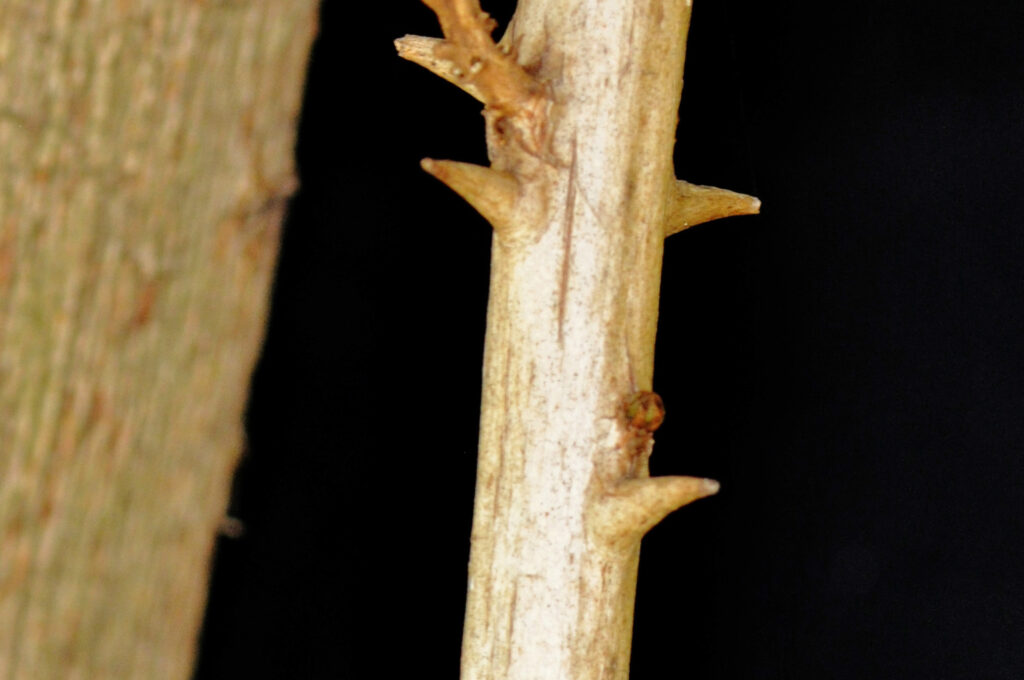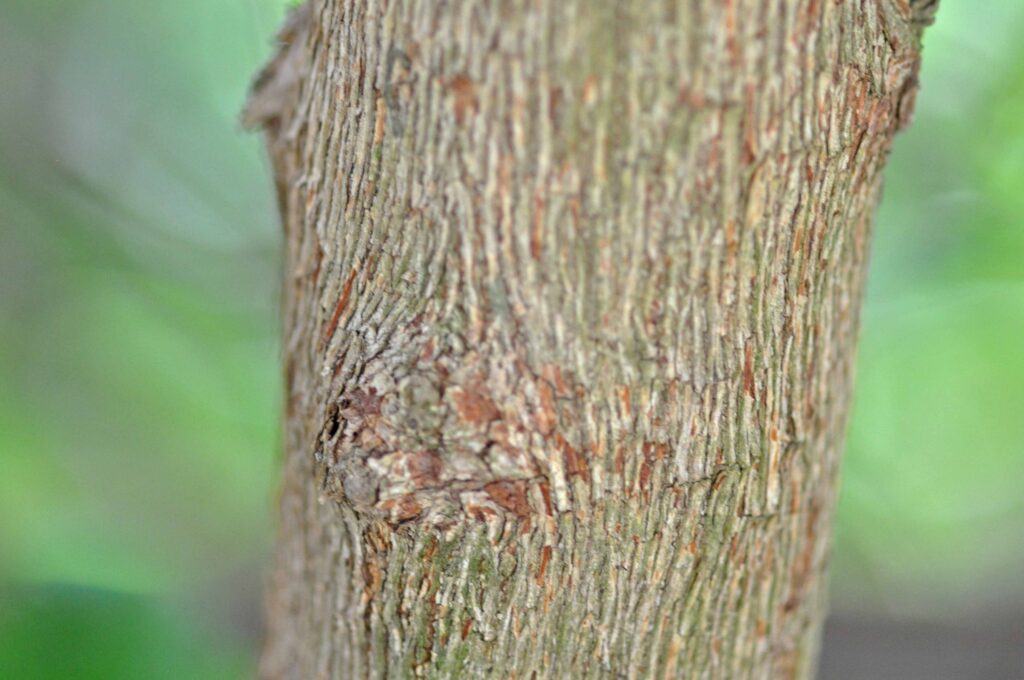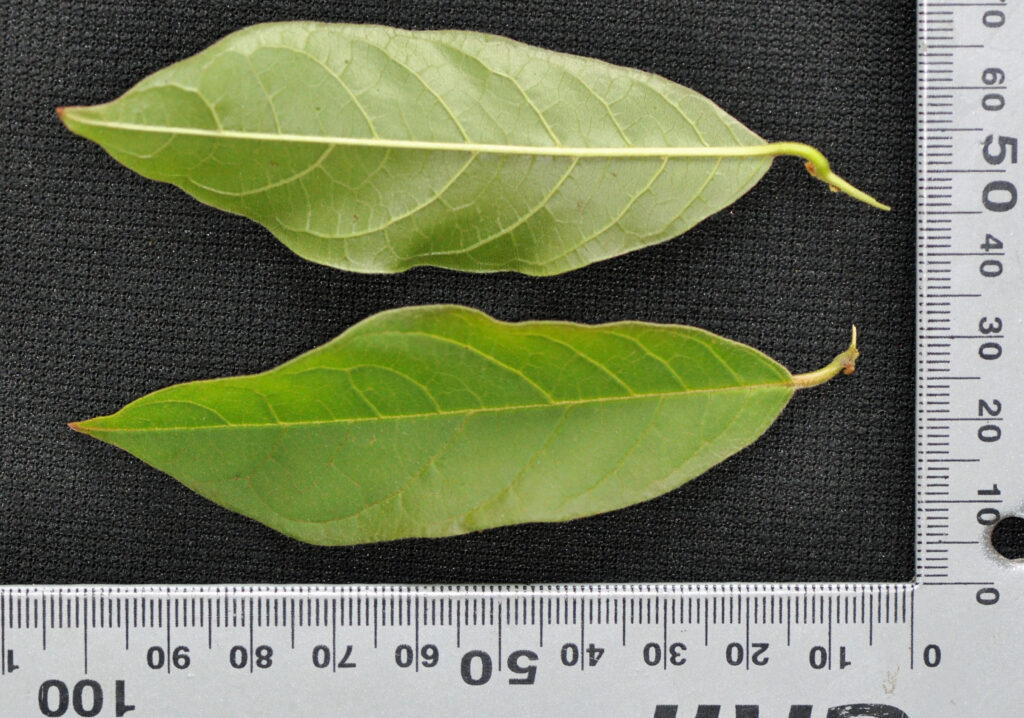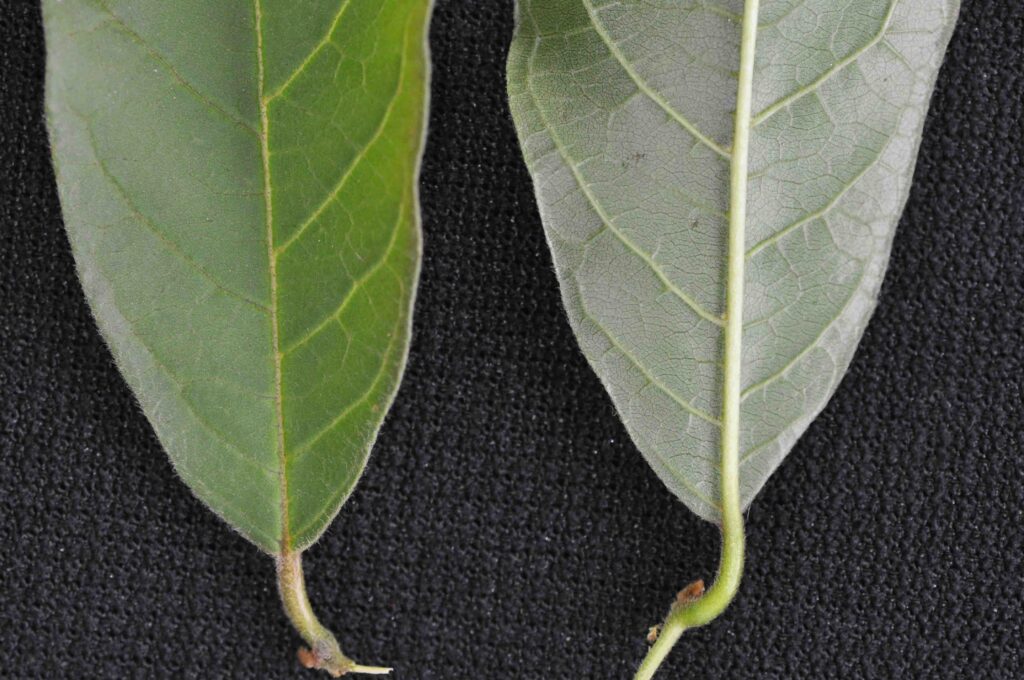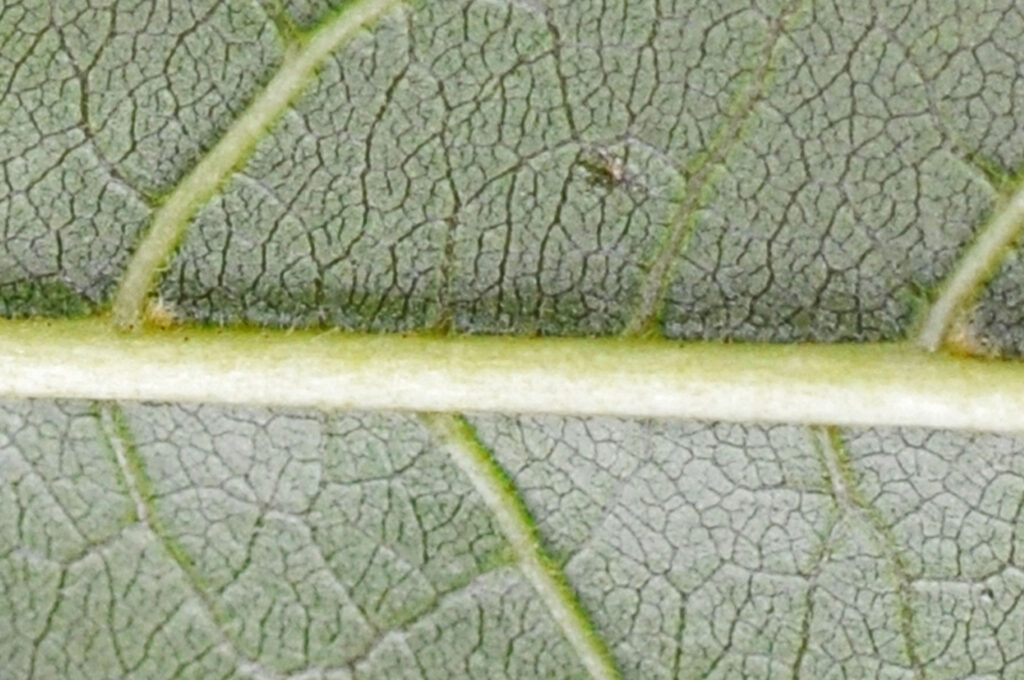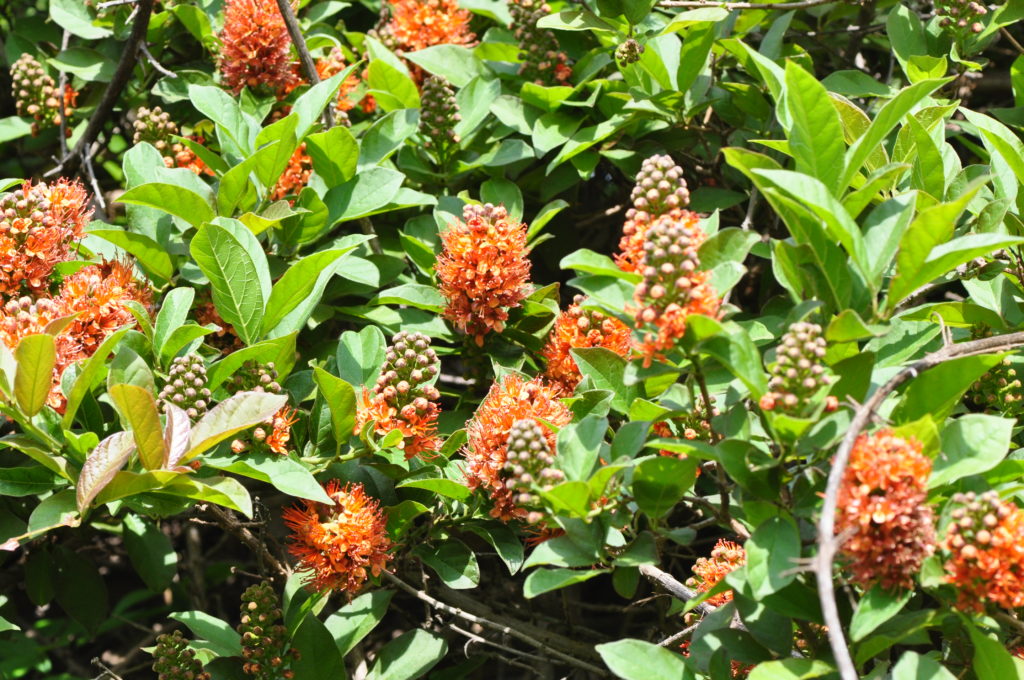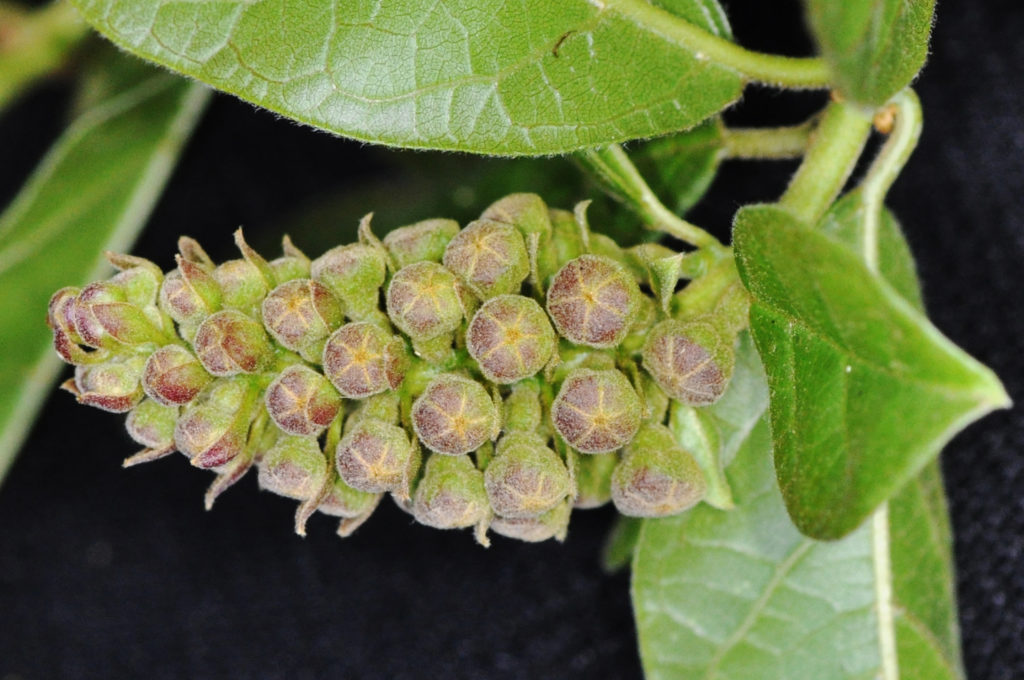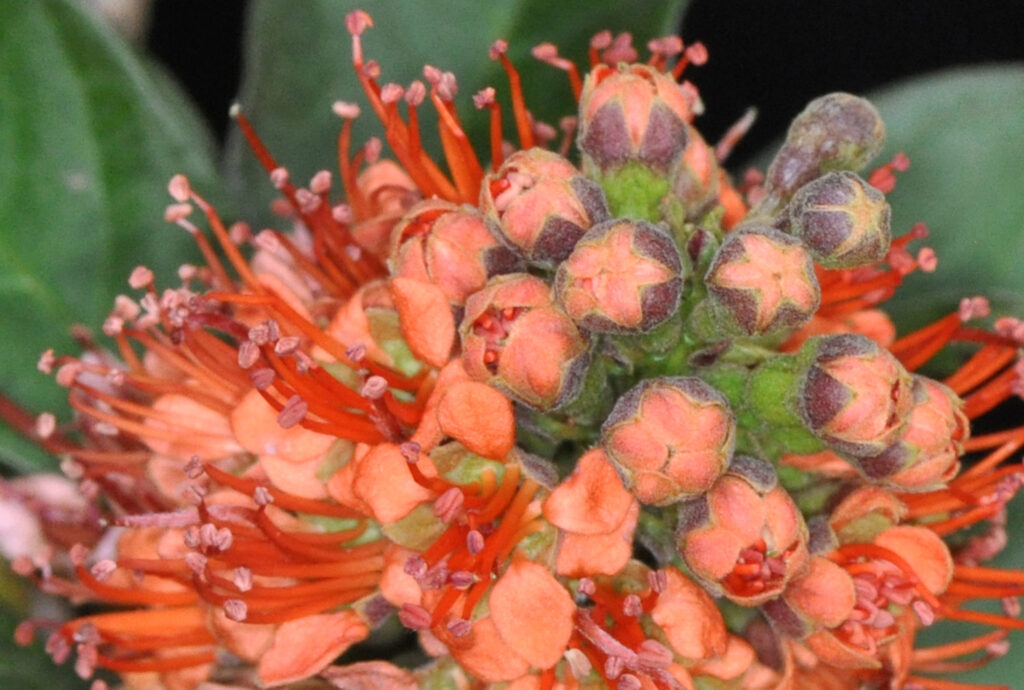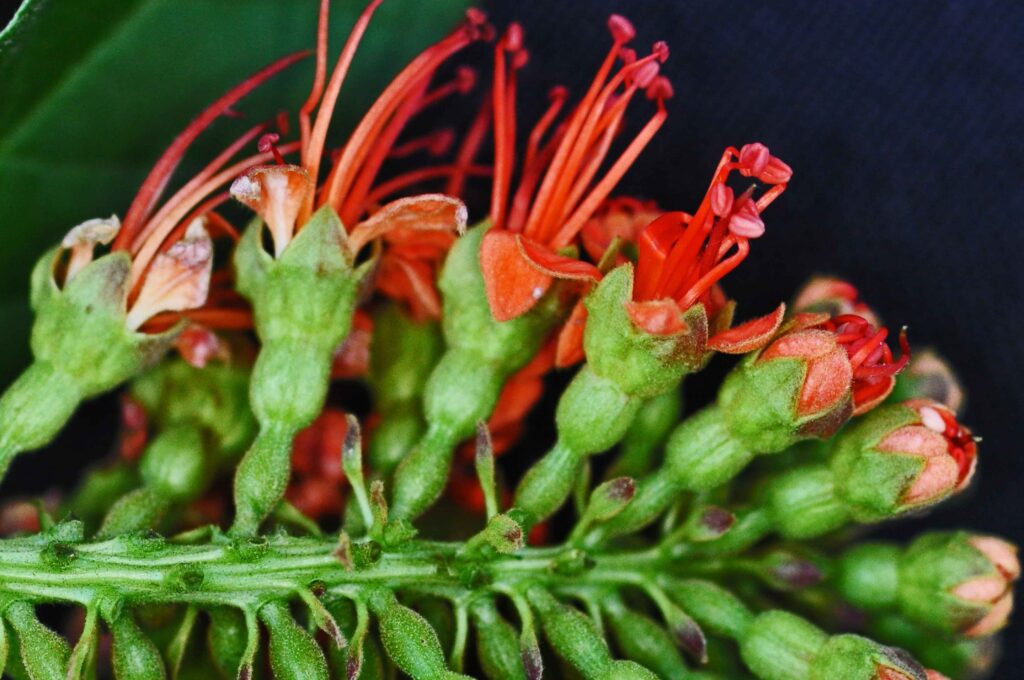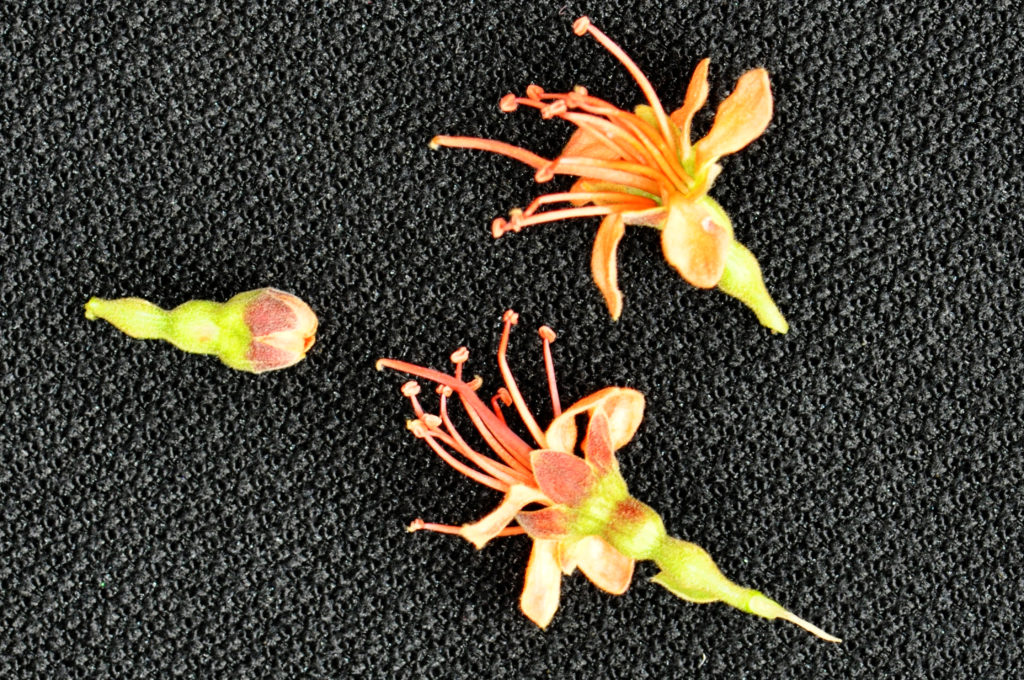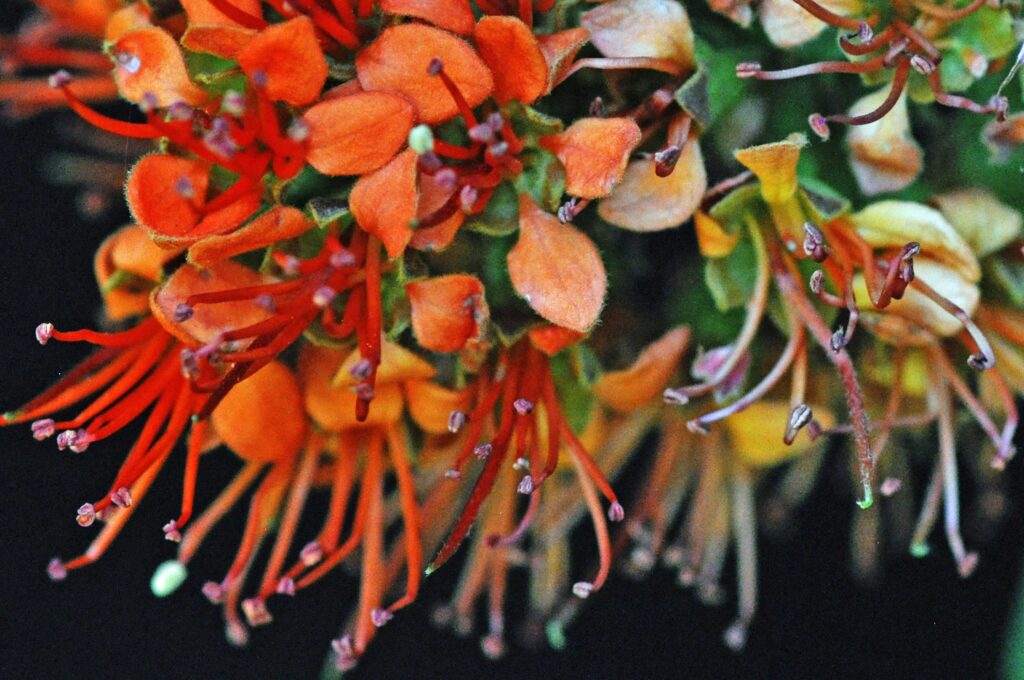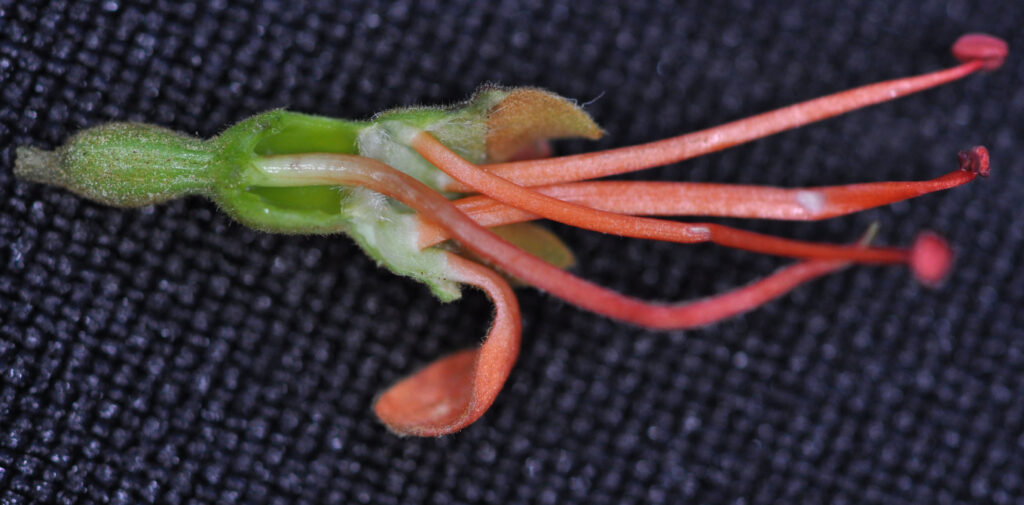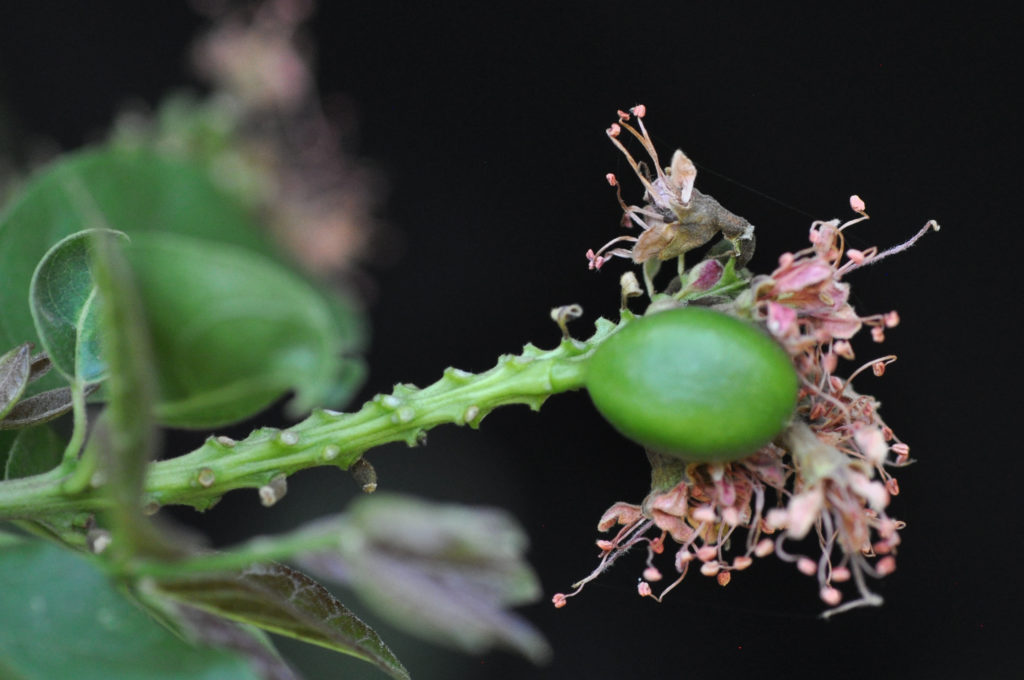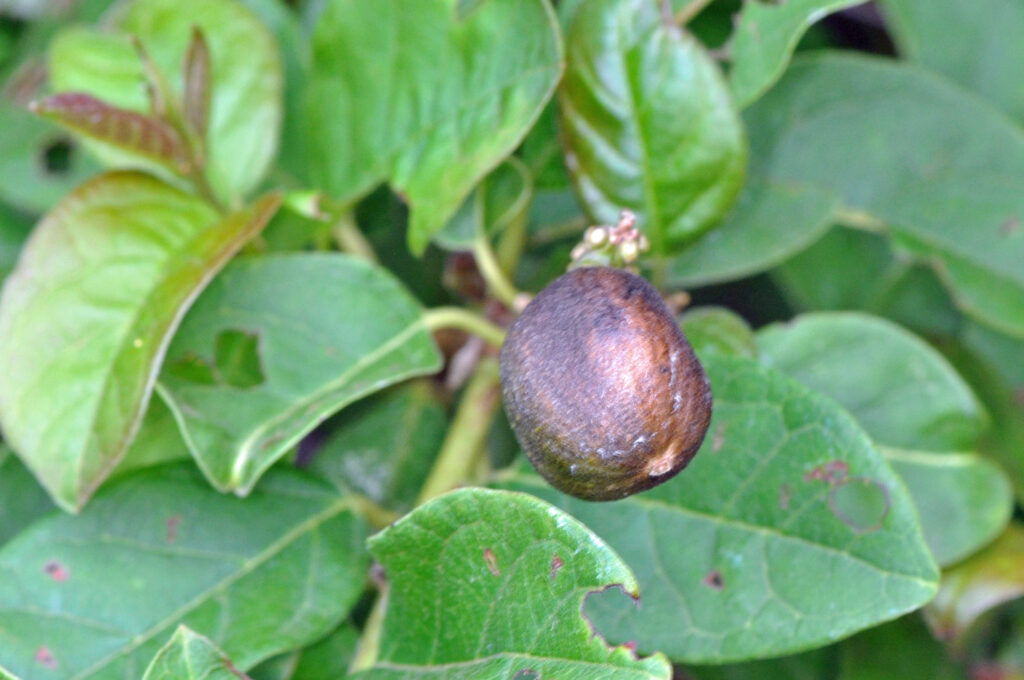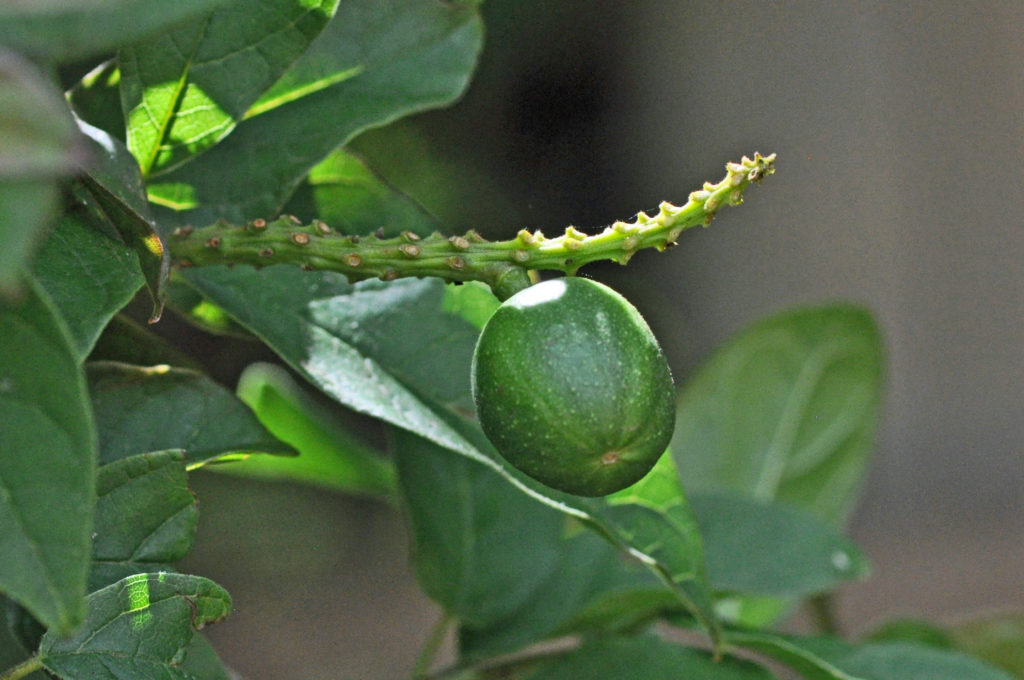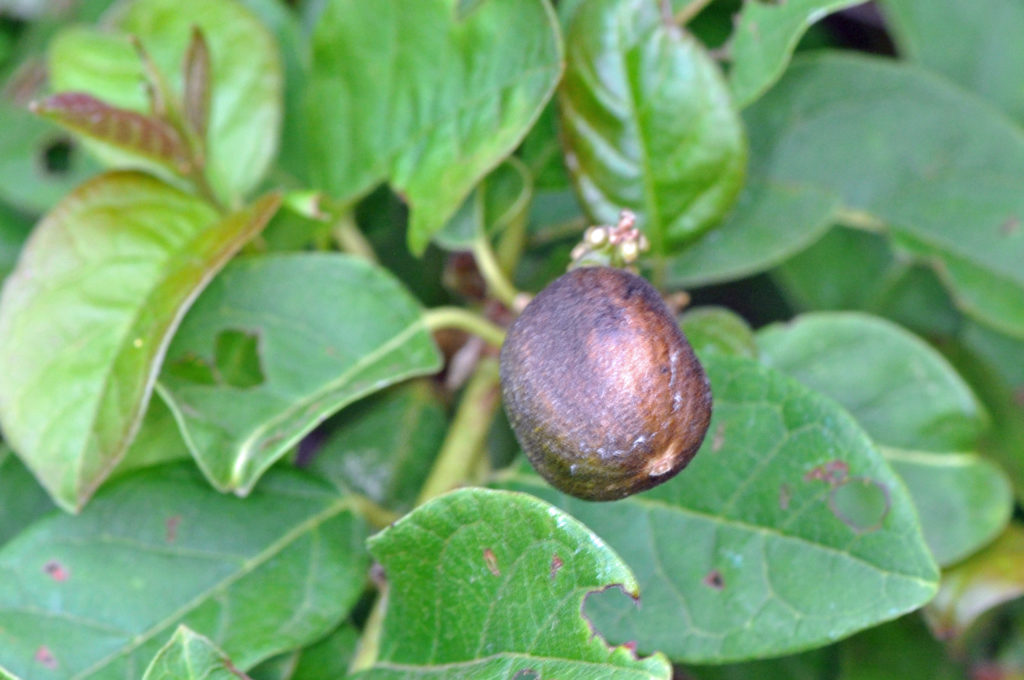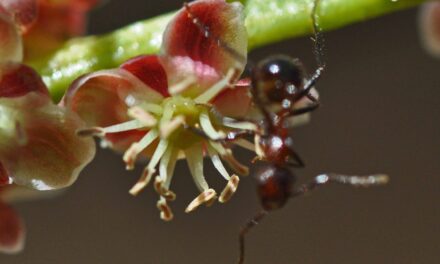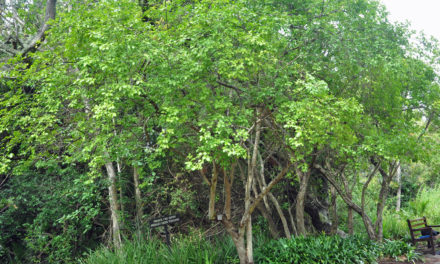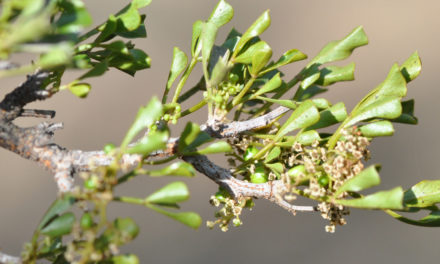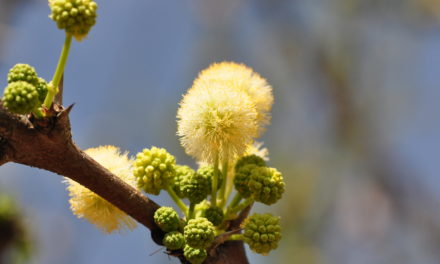General Info – summary
This Tree may reach 8m high but is usually a multi-stemmed shrub. Simple, ovate / elliptic Leaves have entire margins and domatia may be present. Petioles may become thorns and stipules are absent. The red, bisexual, regular, 5 merous (not 4), Flowers are in short dense racemes with large bracts. There are 10 exserted, red stamens – not 8. The ripe Fruit is wingless, hard bony, dark, brown, single seeded nut.
Description
Previous Name: Poivrea bracteosa.
SA Tree No. 532.2.
Common names: (Afr) Hikklimop. (Eng) Hiccough nut, Hiccup-nut. (isiXhosa) Uqoto, Uqota.
Family: Combretaceae (Bushwlillow family). In this family, there are about 16 genera, which contain about 530 species. In South Africa, there are 5 genera and 41 species. Genera with Trees on this website include Combretum, Lumnitzera, Pteleopsis and Terminalia. The simple and usually entire Leaves lack stipules. Flowers are usually bisexual. There are usually twice the number of stamens as sepals or petals. The inferior Ovary has 1 locule and usually only 1 of the ovules develops into a seed. Fruit is usually indehiscent and may be winged or ridged.
Name derivation: Combretum – a climbing plant – referring to some species. bracteosum – having conspicuous or numerous bracts (bract – a much-reduced specialised leaf, particularly the small scale like leaves in a flower cluster or associated with flowers) at the base of the calyx.
Conservation: National Status: L C. (Least Concern). Assessed: 2005 (W. Foden and L. Potter).
Tree
This Tree may reach 8m high, but it is usually a sturdy multi-stemmed much shorter and very attractive Shrub (photos 362 & 259), which can spread to about 6m wide (photo 362). The long narrow Stems are usually unbranched. Plants may be armed with Thorns up to 1,5cm long (photo 258) that aid the tendency of the young branches to climb (photo 362) – including into forest trees. These thorns develop from hardened old persistent Petioles (leaf stalks – photo 258). Thorn remains are still visible on younger branches (photo 259). The Bark is light brown with shallow longitudinal ridges (photo 255) and may flake slightly..
- 362. 2015/09/15. Walter Sisulu NBG. Photo: David Becking.
- 258. 2015/09/15. Walter Sisulu NBG. Photo: David Becking.
- 258. 2015/09/15. Walter Sisulu NBG. Photo: David Becking
- 255. 2015/09/15. Walter Sisulu NBG. Photo: David Becking.
Leaves
The ovate to broadly elliptic Leaves are simple (have a single blade which may have incisions that are not deep enough to divide the leaf into leaflets). They are up to 10 x 5cm and are opposite or nearly so, alternate or whorled. Leaves are dull green on both sides or slightly lighter below (photo 262). In this photo the 7-8 “pairs” of Lateral Veins do not reach the margin but curve up towards the apex where they may loop into each other. These veins may be indented above but prominently protrude below (photo 262R). Here hair-tuft Domatia (a tiny chamber produced by plants that house arthropods. To the naked eye, each domatium appears as a small bump) may appear in vein axils (photo 262RR). The round to tapering Apex may have a sharp tip (photo 262). The Base either tapers or is rounded. The wavy and hairy Margin is entire (with a continuous margin, not in any way indented) and may be rolled under. The hairy Petiole (leaf stalk – photo 262) is up to 1cm long. Stipules (basal appendage of the petiole) are absent. In autumn, the leaves may change to a reddish purple.
- 262. 2015/09/15. Walter Sisulu NBG. Photo: David Becking.
- 262R. 2015/09/15. Walter Sisulu NBG. Photo: David Becking.
- 262RR. 2015/09/15. Walter Sisulu NBG. Photo: David Becking.
Flowers
The bright red to orange Flowers (photo 253) are bisexual and actinomorphic (Regular, symmetrical. Flowers are vertically divisible into similar halves by more than 1 plane passing through the axis). They are grouped together in short dense Racemes (a simple, unbranched, indeterminate inflorescence with individually pedicellate – stalked) flowers along the axis that open in succession towards the apex – (photo 414 in the dissected inflorescence). These racemes occur in leaf axils near the tips of branches (photo 253). This is a special plant when flowering and is visible from a distance. Individual flowers are small. Most local Combretum flowers are 4-merous and have the calyx and corolla in 4’s with 8 Stamens. However here the green (photo 414) to purplish Calyx has 5 Sepals (visible in the buds in photo 402) and the Corolla has 5 orange to scarlet Petals (photos 264 & 870). These petals surround 10 red Stamens that have red protruding Filaments in 2 whorls. The distinctive bright red styles and stamens (filaments and new anthers) distinguish them from other Combretum species (photo 412). The versatile Anthers are dorsifixed. The red filaments together with the red Styles (photo 593) contribute to the impressive flower colour. The Pedicel (stalk of a single flower in a cluster) is about 6mm long (photo 414 in the dissected inflorescence). From the base of the pedicel, clearly visible Bracts arise (usually a much-reduced specialised leaf – photos 402). The single Pistil (female element of the flower containing a stigma style and ovary – photo 593) has a completely inferior Ovary containing a single locule. From the ovary, a free protruding Style emerges (photos, 593 & 412). (Sep-Dec).
- 253. 2015/09/15. Walter Sisulu NBG. Photo: David Becking.
- 402. 2016/09/20. Walter Sisulu NBG. Photo: David Becking.
- 264. 2015/09/15. Walter Sisulu NBG. Photo: David Becking.
- 414. 2017/10/10. Walter Sisulu NBG. Photo: David Becking.
- 593. 2015/09/22. Walter Sisulu NBG. Photo: David Becking.
- 870 2015/09/29 Walter Sisulu NBG. Photo: David Becking.
- 412. 2017/10/10. Walter Sisulu NBG. Photo: David Becking. Dissected
Fruit
The characteristic 4-winged papery fruit in the genus Combretum is lacking in this plant. The fruit is initially green and becomes swollen (photos 355 & 224). In photo 355, the protruding Stamens – remains of old flowers, are still visible. The maturing hard, smooth, almost spherical Fruit (photo 224) is a 2cm wide, wingless Nut (an indehiscent, one seeded, hard bony fruit). It changes from green to reddish and ultimately to dark brown when mature. Here 4-5 ridges are often present. (Dec-Mar+).
- 355. 2015/10/13. Walter Sisulu NBG. Photo: David Becking.
- 224. 2015/12/15. Walter Sisulu NBG. Photo: David Becking.
- 673. 2015/10/27. Walter Sisulu NBG. Photo: David Becking.
- 224. 2015/12/15. Walter Sisulu NBG. Photo: David Becking.
Distribution & Ecology
This tree in Endemic (endemism is the ecological state of a species being unique to a defined geographic location) in South Africa. It is common on forest margins, in dune forests, low altitudes (below 1 200m) and often close to the sea. They occur from the Eastern Cape to KwaZulu-Natal (East London to Richards Bay). These Plants naturally occur close to the sea but do extend inland to an altitude of about 1 200m. A Butterfly – the Striped Policeman (Coeliades forestan var. forestan) has yellowish-white larvae, which feed on the Leaves (and those of some other plants). Adults are mainly brown and white and have a striped abdomen. These butterflies are found from the Eastern Cape and northwards to Zimbabwe and Botswana.
Ethnobotany
This plant was the South African tree of the year in 2004. Propagation. Here Seeds need to be soaked overnight after breaking them out of the hard-outer shell of the fruit. Extracts from mature Leaves can inhibit the corrosion of mild steel by sulphuric acid – to a reasonable extent. These plants are able to withstand light frost and are happy in a coastal environment.
References
Boon, R. 2010. Pooley’s Trees of eastern South Africa. Flora and Fauna Publications Trust, Durban.
Coates Palgrave, M. 2002. Keith Coates Palgrave Trees of Southern Africa, edn 3. Struik, Cape Town.
Foden, W. & Potter, L. 2005. Combretum bracteosum (Hochst.) Engl. & Diels. National Assessment: Red List of South African Plants version . Accessed on 2025/01/10.
Lawrence, G. H. M, 1951. Taxonomy of Vascular Plants. The Macmillan Company, New York. Tenth Printing 1965.
Palmer, E. & Pitman, N. 1972. Trees of southern Africa. Balkema, Amsterdam, Cape Town.
http://www.plantzafrica.com/plantcd/combretbrac.htm
http://www.hear.org/wra/tncflwra/pdfs/tncflwra_combretum_bracteosum_gg.pdf
http://www.botgard.ucla.edu/html/botanytextbooks/lifeforms/climbingplants/b0096tx.html
http://www.aspirewealth.co.za/downloads/sept-2015/Trees-of-the-Year-2000-2020.pdf
http://www.boldsystems.org/index.php/Taxbrowser_Taxonpage?taxid=191747
http://posa.sanbi.org/flora/browse.php?src=SP

